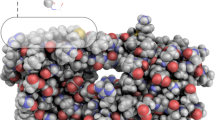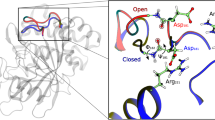Abstract
Conformational changes are known to be able to drive an enzyme through its catalytic cycle, allowing, for example, substrate binding or product release. However, the influence of protein motions on the chemical step is a controversial issue. One proposal is that the simple equilibrium fluctuations incorporated into transition-state theory are insufficient to account for the catalytic effect of enzymes and that protein motions should be treated dynamically. Here, we propose the use of free-energy surfaces, obtained as a function of both a chemical coordinate and an environmental coordinate, as an efficient way to elucidate the role of protein structure and motions during the reaction. We show that the structure of the protein provides an adequate environment for the progress of the reaction, although a certain degree of flexibility is needed to attain the full catalytic effect. However, these motions do not introduce significant dynamical corrections to the rate constant and can be described as equilibrium fluctuations.
This is a preview of subscription content, access via your institution
Access options
Subscribe to this journal
Receive 12 print issues and online access
$259.00 per year
only $21.58 per issue
Buy this article
- Purchase on Springer Link
- Instant access to full article PDF
Prices may be subject to local taxes which are calculated during checkout



Similar content being viewed by others
References
Hammes, G. G., Benkovic, S. J. & Hammes-Schiffer, S. Flexibility, diversity, and cooperativity: pillars of enzyme catalysis. Biochemistry 50, 10422–10430 (2011).
Henzler-Wildman, K. A. et al. A hierarchy of timescales in protein dynamics is linked to enzyme catalysis. Nature 450, 913–916 (2007).
Benkovic, S. J., Hammes, G. G. & Hammes-Schiffer, S. Free-energy landscape of enzyme catalysis. Biochemistry 47, 3317–3321 (2008).
Henzler-Wildman, K. & Kern, D. Dynamic personalities of proteins. Nature 450, 964–972 (2007).
Garcia-Viloca, M., Gao, J., Karplus, M. & Truhlar, D. G. How enzymes work: analysis by modern rate theory and computer simulations. Science 303, 186–195 (2004).
Gao, J. et al. Mechanisms and free energies of enzymatic reactions. Chem. Rev. 106, 3188–3209 (2006).
Olsson, M. H. M., Parson, W. W. & Warshel, A. Dynamical contributions to enzyme catalysis: critical tests of a popular hypothesis. Chem. Rev. 106, 1737–1756 (2006).
Antoniou, D., Basner, J., Núñez, S. & Schwartz, S. D. Computational and theoretical methods to explore the relation between enzyme dynamics and catalysis. Chem. Rev. 106, 3170–3187 (2006).
Nashine, V. C., Hammes-Schiffer, S. & Benkovic, S. J. Coupled motions in enzyme catalysis. Curr. Opin. Chem. Biol. 14, 644–651 (2010).
Ramanathan, A. & Agarwal, P. K. Evolutionarily conserved linkage between enzyme fold, flexibility, and catalysis. PLoS Biol 9, e1001193 (2011).
Zhang, J. & Klinman, J. P. Enzymatic methyl transfer: role of an active site residue in generating active site compaction that correlates with catalytic efficiency. J. Am. Chem. Soc. 133, 17134–17137 (2011).
Bhabha, G. et al. A dynamic knockout reveals that conformational fluctuations influence the chemical step of enzyme catalysis. Science 332, 234–238 (2011).
Adamczyk, A. J., Cao, J., Kamerlin, S. C. L. & Warshel, A. Catalysis by dihydrofolate reductase and other enzymes arises from electrostatic preorganization, not conformational motions. Proc. Natl Acad. Sci. USA 108, 14115–14120 (2011).
Glowacki, D. R., Harvey, J. N. & Mulholland, A. J. Taking Ockham's razor to enzyme dynamics and catalysis. Nature Chem. 4, 169–176 (2012).
Kamerlin, S. C. L. & Warshel, A. At the dawn of the 21st century: is dynamics the missing link for understanding enzyme catalysis? Proteins 78, 1339–1375 (2010).
Warshel, A. et al. Electrostatic basis for enzyme catalysis. Chem. Rev. 106, 3210–3235 (2006).
Kurplus, M & McCammon, J A. Dynamics of proteins: elements and function. Annu. Rev. Biochem. 52, 263–300 (1983).
Marcus, R. A. Chemical and electrochemical electron-transfer theory. Annu. Rev. Phys. Chem. 15, 155–196 (1964).
Kosugi, T. & Hayashi, S. Crucial role of protein flexibility in formation of a stable reaction transition state in an α-amylase catalysis. J. Am. Chem. Soc. 134, 7045–7055 (2012).
Pang, J., Pu, J., Gao, J., Truhlar, D. G. & Allemann, R. K. Hydride Transfer reaction catalyzed by hyperthermophilic dihydrofolate reductase is dominated by quantum mechanical tunneling and is promoted by both inter- and intramonomeric correlated motions. J. Am. Chem. Soc. 128, 8015–8023 (2006).
Kanaan, N. et al. Temperature dependence of the kinetic isotope effects in thymidylate synthase. A theoretical study. J. Am. Chem. Soc. 133, 6692–6702 (2011).
Hay, S. & Scrutton, N. S. Good vibrations in enzyme-catalysed reactions. Nature Chem. 4, 161–168 (2012).
Pu, J., Gao, J. & Truhlar, D. G. Multidimensional tunneling, recrossing, and the transmission coefficient for enzymatic reactions. Chem. Rev. 106, 3140–3169 (2006).
Boekelheide, N., Salomón-Ferrer, R. & Miller, T. F. Dynamics and dissipation in enzyme catalysis. Proc. Natl Acad. Sci. USA 108, 16159–16163 (2011).
Garrett, B. C. & Truhlar, D. G. in Theory and Applications of Computational Chemistry (eds Dykstra, C. E., Frenking, G., Kim, K. S. & Scuseria, G. E.) 67–87 (Elsevier, 2005).
Grote, R. F. & Hynes, J. T. The stable states picture of chemical reactions. II. Rate constants for condensed and gas phase reaction models. J. Chem. Phys. 73, 2715–2732 (1980).
Bergsma, J. P., Gertner, B. J., Wilson, K. R. & Hynes, J. T. Molecular dynamics of a model SN2 reaction in water. J. Chem. Phys. 86, 1356–1376 (1987).
Ruiz-Pernía, J. J., Tuñón, I., Moliner, V., Hynes, J. T. & Roca, M. Dynamic effects on reaction rates in a Michael addition catalyzed by chalcone isomerase. Beyond the frozen environment approach. J. Am. Chem. Soc. 130, 7477–7488 (2008).
Gertner, B. J., Bergsma, J. P., Wilson, K. R., Lee, S. & Hynes, J. T. Nonadiabatic solvation model for SN2 reactions in polar solvents. J. Chem. Phys. 86, 1377–1386 (1987).
Hwang, J. K., King, G., Creighton, S. & Warshel, A. Simulation of free energy relationships and dynamics of SN2 reactions in aqueous solution. J. Am. Chem. Soc. 110, 5297–5311 (1988).
Gertner, B. J., Wilson, K. R. & Hynes, J. T. Nonequilibrium solvation effects on reaction rates for model SN2 reactions in water. J. Chem. Phys. 90, 3537–3558 (1989).
Ruiz-Pernía, J. J., Martí, S., Moliner, V. & Tuñón, I. A novel strategy to study electrostatic effects in chemical reactions: differences between the role of solvent and the active site of chalcone isomerase in a Michael addition. J. Chem. Theory Comput. 8, 1532–1535 (2012).
Janssen, D. B., Scheper, A., Dijkhuizen, L. & Witholt, B. Degradation of halogenated aliphatic-compounds by Xanthobacter autotrophicus GJ10. Appl. Environ. Microbiol. 49, 673–677 (1985).
Schanstra, J. P., Kingma, J. & Janssen, D. B. Specificity and kinetics of haloalkane dehalogenase. J. Biol. Chem. 271, 14747–14753 (1996).
Devi-Kesavan, L. S. & Gao, J. Combined QM/MM study of the mechanism and kinetic isotope effect of the nucleophilic substitution reaction in haloalkane dehalogenase. J. Am. Chem. Soc. 125, 1532–1540 (2003).
Shurki, A., Štrajbl, M., Villà, J. & Warshel, A. How much do enzymes really gain by restraining their reacting fragments? J. Am. Chem. Soc. 124, 4097–4107 (2002).
Soriano, A. et al. Electrostatic effects in enzyme catalysis: a quantum mechanics/molecular mechanics study of the nucleophilic substitution reaction in haloalkane dehalogenase. Theor. Chem. Accounts 112, 327–334 (2004).
Soriano, A., Silla, E., Tuñón, I. & Ruiz-Lopez, M. F. Dynamic and electrostatic effects in enzymatic processes. An analysis of the nucleophilic substitution reaction in haloalkane dehalogenase. J. Am. Chem. Soc. 127, 1946–1957 (2005).
Okamoto, K., Kita, T., Araki, K. & Shingu, H. Kinetic studies of bimolecular nucleophilic substitution. 4. Rates of SN2 and E2 reactions of beta-substituted ethyl chlorides with sodium acetate in aqueous solutions. B. Chem. Soc. Jpn 40, 1913 (1967).
Truhlar, D. G. & Garrett, B. C. Variational transition-state theory. Acc. Chem. Res. 13, 440–448 (1980).
Stewart, J. J. P. Optimization of parameters for semiempirical methods I. Method. J. Comput. Chem. 10, 209–220 (1989).
Jorgensen, W. L., Maxwell, D. S. & Tirado-Rives, J. Development and testing of the OPLS all-atom force field on conformational energetics and properties of organic liquids. J. Am. Chem. Soc. 118, 11225–11236 (1996).
Jorgensen, W. L., Chandrasekhar, J., Madura, J. D., Impey, R. W. & Klein, M. L. Comparison of simple potential functions for simulating liquid water. J. Chem. Phys. 79, 926–935 (1983).
Gao, J. & Xia, X. A two-dimensional energy surface for a type II SN2 reaction in aqueous solution. J. Am. Chem. Soc. 115, 9667–9675 (1993).
Verschueren, K. H., Seljée, F., Rozeboom, H. J., Kalk, K. H. & Dijkstra, B. W. Crystallographic analysis of the catalytic mechanism of haloalkane dehalogenase. Nature 363, 693–698 (1993).
Olsson, M. H. M., Søndergaard, C. R., Rostkowski, M. & Jensen, J. H. PROPKA3: consistent treatment of internal and surface residues in empirical pKa predictions. J. Chem. Theory Comput. 7, 525–537 (2011).
Torrie, G. M. & Valleau, J. P. Nonphysical sampling distributions in Monte Carlo free-energy estimation: umbrella sampling. J. Comput. Phys. 23, 187–199 (1977).
Kumar, S., Rosenberg, J. M., Bouzida, D., Swendsen, R. H. & Kollman, P. A. The weighted histogram analysis method for free-energy calculations on biomolecules. I. The method. J. Comput. Chem. 13, 1011–1021 (1992).
Zhao, Y. & Truhlar, D. G. The M06 suite of density functionals for main group thermochemistry, thermochemical kinetics, noncovalent interactions, excited states, and transition elements: two new functionals and systematic testing of four M06-class functionals and 12 other functionals. Theor. Chem. Accounts 120, 215–241 (2008).
Acknowledgements
The authors acknowledge financial support from the Ministerio de Economía y Competitividad (MEC) through project CTQ2012-36253-C03. J.J.R-P. thanks a Juan de la Cierva contract and R.G-M. a FPU fellowship of the Ministerio de Economía y Competitividad. I.T. acknowledges helpful discussions held with D. Laage and J. T. Hynes during his sabbatical stay at the École Normale Supérieure, France. The authors acknowledge computational facilities of the Servei d'Informàtica de la Universitat de València on the ‘Tirant’ supercomputer.
Author information
Authors and Affiliations
Contributions
I.T., V.M. and J.J.R‐P. designed the computational experiments. S.M. wrote the code and R.G-M. performed the calculations. I.T., V.M. and J.J.R-P. co-wrote the first version of the paper. All the authors commented and discussed the results and the final version of the manuscript.
Corresponding authors
Ethics declarations
Competing interests
The authors declare no competing financial interests.
Rights and permissions
About this article
Cite this article
García-Meseguer, R., Martí, S., Ruiz-Pernía, J. et al. Studying the role of protein dynamics in an SN2 enzyme reaction using free-energy surfaces and solvent coordinates. Nature Chem 5, 566–571 (2013). https://doi.org/10.1038/nchem.1660
Received:
Accepted:
Published:
Issue Date:
DOI: https://doi.org/10.1038/nchem.1660



